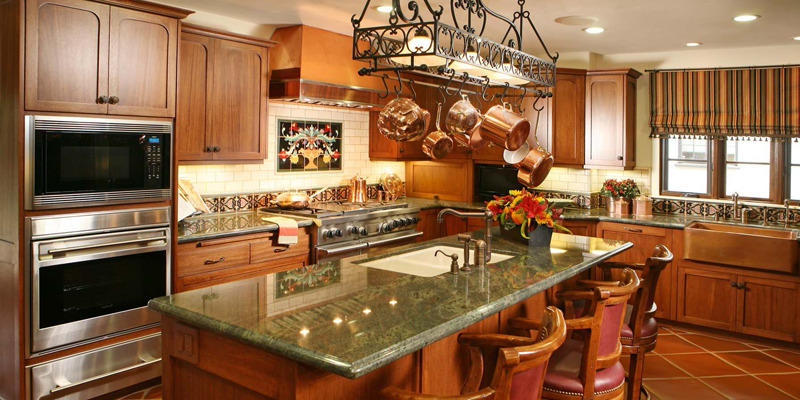How to Create a Spanish-Style Kitchen Design

The kitchen is arguably the most important room in your home. Its focal point, the kitchen island, serves as an integral place for all major family activities—eating, cooking together, socializing around a cup of coffee or tea. Because kitchens act as both a utilitarian hub and unofficial gathering spot for loved ones, it’s paramount that they are pleasing aesthetically to you and your family members.
That said, if you’re planning to remodel your kitchen this year (and who isn’t?), why not create an inviting Spanish-style kitchen design? Inspired by Mediterranean architecture with its warm color palette and soft lines, Spanish-style kitchens can easily become the heart of your home without breaking the bank on expensive renovations. Here are some simple yet effective ways to start brainstorming your own Spanish kitchen.
What is a Spanish-Style Kitchen?

First thing’s first, what exactly is a “Spanish-style” kitchen? Many people confuse the term “Spanish-style” with Spanish mission or Mediterranean style. While all of these styles are related, they fall under different categories and have distinct characteristics that separate them from one another.
A Spanish-style kitchen design is defined by its color palette, which tends to lean towards soft hues of reds, oranges, yellows, and deep browns rather than stark whites or trendy grays.
Often found in historic homes dating back to Moorish influence (hence the name “Moorish Revival”), this warm design scheme creates an inviting atmosphere; your kitchen will feel like a cozy escape—even when it’s hectic! Soft colors also make decorating easy because there’s no need for extensive paint treatments. Simply painting your cabinets or changing your hardware will go a long way in creating an entirely new style.
Spanish-style kitchens are also defined by their gently sloping lines, which create deep cabinets and wide countertops. To enhance this effect, incorporate heaving crown molding or paneled walls into your design to give it depth. You can even mimic the look of wainscoting to expand the appearance of your kitchen’s height. This classic yet timelessly stylish detail gives your kitchen a sophisticated touch that’ll be sure to impress company and family alike!
Terracotta Tiles: Spanish Kitchen Island Must-Haves

If there’s one decor element that is quintessentially Spanish, it’s terracotta tiles.
Found in everything from homes to churches to local eateries, terracotta tiles add a touch of elegance and warmth—two characteristics inherent in any classic Spanish design. Unfortunately, when most people think of terracotta tiles, they automatically envision their grandmother’s dated bathroom flooring—a far cry from the inviting atmosphere we’re aiming for! Fortunately, there are a few ways to work this timelessly fashionable feature into your kitchen design without sacrificing style or affordability:
1. Kitchen Island:
Terracotta tiles are the perfect materials to use when creating a kitchen island because their durability and subtle color palette allow them to seamlessly blend in with other decor elements while still providing eye-catching style! For example, you can create an all-terracotta backsplash behind your kitchen sink or simply alternate terracotta tiles with glass subway tile on your backsplash for added flair. The more creative you get with this seemingly simple feature, the bigger return on investment (ROI) you’ll get. Just remember that if you’re working within a smaller budget, it’s best to stick to one focal point; otherwise, this beautiful material can quickly turn overwhelming—which is anything but inviting!
2. Placing Tiles throughout Kitchen:
Another way to incorporate terracotta tiles into your kitchen is by placing them throughout. For instance, you can tile your stovetop backsplash for added pizzazz or create an original floor design with small hexagonal or square terracotta tiles. Because these small faux-tile pieces are so inexpensive, the possibilities are endless! Plus, they’re easy to replace if one breaks in the middle of cooking dinner—just make sure you hire a professional to do the installation work. Otherwise, enjoy yourself and let us know how it’s going!
When it comes down to it, Spanish-style kitchens are all about bringing together complementary elements and finding clever ways to infuse color and pattern. With some skillful DIY-ing and a touch of creativity, you can create your very own Spanish oasis in no time—with the help of professionals, of course!
Things to Avoid in a Spanish-Style Kitchen Design

Unlike many contemporary styles, Spanish-style kitchens are infinitely more forgiving in terms of design. This is largely due to the fact that this kitchen style falls into the casual category, allowing you to incorporate just about any style you please, as long as it’s not too modern!
To achieve a truly authentic look with your Spanish-style kitchen, steer clear of anything overly sleek or streamlined. For example, if you want your cabinets to mimic old-world charm, avoid flat fronts and opt for contoured shapes instead.
Instead of using metal finishes when it comes to hardware, use materials like pewter or iron. Finally, keep an eye out for features like glass cabinet inserts; these sky blue accents can be purchased separately at most home improvement stores and will definitely give your kitchen that one-of-a-kind touch it needs to stand out.
Why Hire a Professional to Design Your Spanish Kitchen

Spanish kitchens are designed for family living. Their warm, inviting atmosphere makes them perfect for hosting large dinner parties or holiday celebrations. To make sure you get the most use (and enjoyment!) out of your new design, hire our team of remodeling experts today. We can bring together all of your cooking and dining dreams into one fully functional reality!
Frequently Asked Questions about Spanish Kitchen Remodels in San Diego
